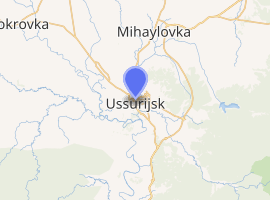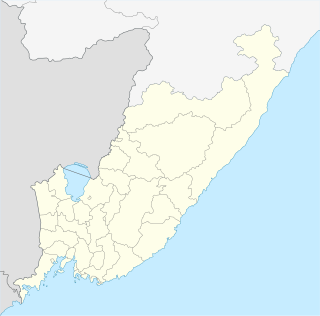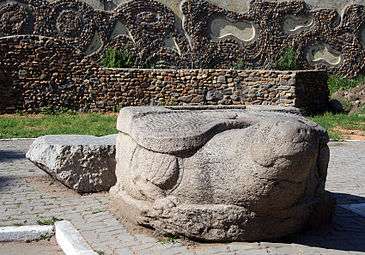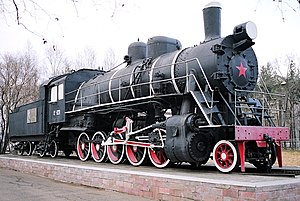Ussuriysk
Ussuriysk (Russian: Уссури́йск) is a city in Primorsky Krai, Russia, located in the fertile valley of the Razdolnaya River, 98 kilometers (61 mi) north of Vladivostok, the administrative center of the krai, and about 60 kilometers (37 mi) from both the China–Russia border and the Pacific Ocean. Population: 158,004 (2010 Census);[2] 157,759 (2002 Census);[7] 158,016 (1989 Census).[8]
Ussuriysk Уссурийск | |
|---|---|
City[1] | |
Nekrasova Street in Ussuriysk | |
.png) Coat of arms | |
Location of Ussuriysk 
| |
 Ussuriysk Location of Ussuriysk  Ussuriysk Ussuriysk (Primorsky Krai) | |
| Coordinates: 43°48′N 131°58′E | |
| Country | Russia |
| Federal subject | Primorsky Krai[1] |
| Founded | 1866 |
| City status since | 1898 |
| Government | |
| • Head | Korzh Yevgeniy Yevgen'yevich |
| Area | |
| • Total | 173 km2 (67 sq mi) |
| Elevation | 33 m (108 ft) |
| Population | |
| • Total | 158,004 |
| • Estimate (2018)[3] | 172,017 (+8.9%) |
| • Rank | 111th in 2010 |
| • Density | 910/km2 (2,400/sq mi) |
| • Subordinated to | Ussuriysk City Under Krai Jurisdiction[1] |
| • Capital of | Ussuriysk City Under Krai Jurisdiction[1] |
| • Urban okrug | Ussuriysky Urban Okrug[4] |
| • Capital of | Ussuriysky Urban Okrug[4] |
| Time zone | UTC+10 (MSK+7 |
| Postal code(s)[6] | 692500–692503, 692506, 692508–692512, 692515, 692519, 692522–692530, 692548–692554, 692558, 692559 |
| Dialing code(s) | +7 4234 |
| OKTMO ID | 05723000001 |
| Website | adm-ussuriisk |
It was previously known as Nikolskoye (until 1898), Nikolsk-Ussuriysky (until 1935), Voroshilov (until 1957).
History
Medieval history

The area of what now is Ussuriysk was settled by Yulou Mohe tribes. From the mid-9th century, it became Solbin-bu of the Balhae Kingdom. It is then populated by the Dōnghǎi Jurchens, under control of Liao dynasty. The city then become capital of Jīn Dynasty's Sùpín circuit (速頻路). Then it went under control of Yuan, Ming and Qing dynasties respectively.
Modern era
In 1866, the settlement of Nikolskoye (Нико́льское) was founded on the area of today's Ussuriysk, named after Saint Nicholas. Due to its advantageous geographic location at the crossing of the transportation lines, the village experienced rapid growth during the 1870s, turning into a trade center. Its role increased after the railroad connecting Khabarovsk and Vladivostok (now a part of the Trans-Siberian Railway) was built, and in 1898 it was granted town status and renamed Nikolsk-Ussuriysky (Нико́льск-Уссури́йский).
By the beginning of the 20th century the town's population totaled 15,000 people, and the annual turnover of its trade enterprises was equal to three million rubles. After the Russo-Japanese War of 1904-1905, Nikolsk-Ussuriysky became one of the most important commercial and economic centers of the Russian Far East. In 1913, the city ranked fourth after Vladivostok, Blagoveshchensk, and Khabarovsk in terms of population. Enterprises were established processing agricultural products such as mills, dairies, soap-boiling plants, and tanneries, as well as macaroni and sausage factories and breweries. Brick factories, quarries, and saw-mills were also built.
The central part of the city began to be built up with two- and three-story masonry buildings. In 1914, there were fourteen educational institutions, a theater, a circus, and three movie-theaters in Nikolsk-Ussuriysky.
After the October Revolution of 1917, the city's economy experienced rapid growth. The city specialized in processing agricultural products. The name of the city was changed to Voroshilov in 1935 after Kliment Voroshilov. With Nikita Khrushchev's ascent to power after Stalin's death the city's name was changed in 1957 to Ussuriysk after the Ussuri River, which is more than 140 km away.
Until the 1980s, the city ranked second in the krai in population, having only recently yielded to Nakhodka. Ussuriysk is still second only to Vladivostok as a theatrical and higher-educational center (it is home to the Pedagogical and Agricultural Institutes, and the Higher Military School).
Administrative and municipal status
Within the framework of administrative divisions, it is, together with thirty-seven rural localities, incorporated as Ussuriysk City Under Krai Jurisdiction—an administrative unit with the status equal to that of the districts.[1] As a municipal division, Ussuriysk City Under Krai Jurisdiction is incorporated as Ussuriysky Urban Okrug.[4]
Economy
The city's industry is represented by twenty-eight enterprises, including twelve of the food industry, two of light industry, six of metal industry, and four of construction industry. Ussuriysk has always specialized in the production of consumer goods. That is why at present it is in a more favorable situation as compared with other large cities of Primorye where enterprises of war industry prevailed. The largest enterprises of light industry are Primorsky Sakhar (which provides the Russian Far East with sugar, producing 160,000 tonnes per year), Dalsoya (which produces vegetable oil, margarine, and soap), Ussuriysky Balsam (24 kinds of liqueur and vodka products, and balsams made of a blend of dozens of herbs). Five articles of Ussuriysky Balsam were given diplomas of the first and the second degrees at all-Russian competition of alcohol products.
One more economic feature of Ussuriysk is its wholesale trade. There are approximately thirty specialized and multipurpose trade bases, many of which had developed contacts with foreign partners before the external economic policy was liberalized in Russia.
Among the city's other enterprises that are worth mentioning are the Grado firm which annually produces up to 600,000 pairs of footwear, and the Locomotive Repairing Plant. The annual industrial output of Ussuriysk equals 8% of Primorsky Krai's production. Besides, the city is the crossing point of all major highways and railroads of the krai.
Theaters
The Ussuriysk Drama Theater of the Eastern Military District is located at #31 Sovyetskaya Street. The theater was founded in 1937 and is one of the two theaters of the Russian Army (the other is the Central Theater of the Russian Army in Moscow). The theater maintains the military–patriotic tendency and realistic style.
The Ussuriysk Drama Theater is located at #33 Volodarskogo Street. It was opened in 1937. The theater is of classical tendencies. Plays are staged both for adults and children. The hall can accommodate 428 people.
Architecture and monuments
The central part of the city, including Lenina, Chicherina, Krasnoznamyonnaya, and Ageyeva Streets, is of historic value. The city's oldest hotel (#28 Lenina St.) was constructed in 1880. #53 Lenina St., which houses the city's oldest movie-theater Grand-Illyuzion, was built in 1908.
On the central square there is a monument to the Red Guards and partisans, who died in the battles at Ussuriysk in June 1918. A monument to Vladimir Lenin is on the Railway Station Square.
Steam locomotive YeL 629 is set on plinth as a memorial to three Bolshevik revolutionaries (Lazo, Lutsky, and Sibirtsev) who were allegedly burned alive by the White Guards in its firebox in 1920.

The Intercession Church at #80A Chicherina St. was built in 1914. It is the only religious building in the krai that has been kept without any reconstruction since 1917 and is used for its original purpose.
Notable people
Landscape
Ussuriysk is very green because of many trees (such as poplars, elms, and jasmine, have been transplanted here from the taiga) and ranked third after Arsenyev and Vladivostok.
Twin towns and sister cities
Ussuriysk is twinned with:
References
Notes
- Law #161-KZ
- Russian Federal State Statistics Service (2011). "Всероссийская перепись населения 2010 года. Том 1" [2010 All-Russian Population Census, vol. 1]. Всероссийская перепись населения 2010 года [2010 All-Russia Population Census] (in Russian). Federal State Statistics Service.
- "26. Численность постоянного населения Российской Федерации по муниципальным образованиям на 1 января 2018 года". Federal State Statistics Service. Retrieved January 23, 2019.
- Law #131-KZ
- "Об исчислении времени". Официальный интернет-портал правовой информации (in Russian). June 3, 2011. Retrieved January 19, 2019.
- Почта России. Информационно-вычислительный центр ОАСУ РПО. (Russian Post). Поиск объектов почтовой связи (Postal Objects Search) (in Russian)
- Russian Federal State Statistics Service (May 21, 2004). "Численность населения России, субъектов Российской Федерации в составе федеральных округов, районов, городских поселений, сельских населённых пунктов – районных центров и сельских населённых пунктов с населением 3 тысячи и более человек" [Population of Russia, Its Federal Districts, Federal Subjects, Districts, Urban Localities, Rural Localities—Administrative Centers, and Rural Localities with Population of Over 3,000] (XLS). Всероссийская перепись населения 2002 года [All-Russia Population Census of 2002] (in Russian).
- "Всесоюзная перепись населения 1989 г. Численность наличного населения союзных и автономных республик, автономных областей и округов, краёв, областей, районов, городских поселений и сёл-райцентров" [All Union Population Census of 1989: Present Population of Union and Autonomous Republics, Autonomous Oblasts and Okrugs, Krais, Oblasts, Districts, Urban Settlements, and Villages Serving as District Administrative Centers]. Всесоюзная перепись населения 1989 года [All-Union Population Census of 1989] (in Russian). Институт демографии Национального исследовательского университета: Высшая школа экономики [Institute of Demography at the National Research University: Higher School of Economics]. 1989 – via Demoscope Weekly.
Sources
- Законодательное Собрание Приморского края. Закон №161-КЗ от 14 ноября 2001 г. «Об административно-территориальном устройстве Приморского края», в ред. Закона №673-КЗ от 6 октября 2015 г. «О внесении изменений в Закон Приморского края "Об административно-территориальном устройстве Приморского края"». Вступил в силу со дня официального опубликования. Опубликован: "Красное знамя Приморья", №69 (119), 29 ноября 2001 г. (Legislative Assembly of Primorsky Krai. Law #161-KZ of November 14, 2001 On the Administrative-Territorial Structure of Primorsky Krai, as amended by the Law #673-KZ of October 6, 2015 On Amending the Law of Primorsky Krai "On the Administrative-Territorial Structure of Primorsky Krai". Effective as of the official publication date.).
- Законодательное Собрание Приморского края. Закон №131-КЗ от 6 августа 2004 г. «Об Уссурийском городском округе», в ред. Закона №123-КЗ от 13 ноября 2012 г. «О внесении изменений в отдельные законодательные акты Приморского края в связи с изменением наименований некоторых сельских населённых пунктов Приморского края». Вступил в силу со дня официального опубликования. Опубликован: "Ведомости Законодательного Собрания Приморского края", №65, 9 августа 2004 г. (Legislative Assembly of Primorsky Krai. Law #131-KZ of August 6, 2004 On Ussuriysky Urban Okrug, as amended by the Law #123-KZ of November 13, 2012 On Amending Various Legislative Acts of Primorsky Krai Due to the Changes of Names of Some Rural Inhabited Localities of Primorsky Krai. Effective as of the day of the official publication.).
External links
- Ussuriysk at the Encyclopædia Britannica